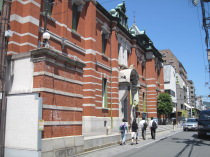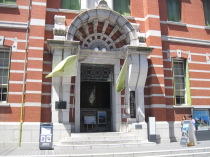Weekly Topics/Archive
May 2013
|
�@I have watched the exhibition, the Inka Empire Revealed �G Century After
the Machu Picchu �gDiscovery�h.
It introduces the latest achievements of research on the Inka Empire which
is the last country in ancient
Peru and its city, Machu Picchu.
Let me introduce you to a part of them.
�@The exhibition is at the Museum of Kyoto facing Sanjyo Street, which is
located 7 minute's walk from Karasuma-Oike Station on the Kyoto Municipal
Subway Line.
It's the first time I visit this museum.

The Museum of Kyoto
(Important Cultural properties) |
|

The main entrance of
the Museum of Kyoto |
|

The guide plate of the Museum
of Kyoto |
|
�@This building was designed by Kingo Tatsuno who is considered one of the
forefather of modern
architecture in Japan and his pupil.
It was completed in the 39th year of the Meiji period (1906).
It had been used as the Kyoto branch of the Bank of Japan.
Kingo Tatuno is known as the designer of Tokyo Station.
It resembles somewhat Tokyo Station in appearance, doesn't it?
�@It has been 100 years since Machu Picche was discovered by a US historian
, I heard.
In commemoration of it, a full picture of the Inka Empire was introduced
with almost 160 cultural properties.
Let me introduce you to the most representative of those.
|
|
�@��
A gold alloy
image of a person
(Male and female) |
�@An ancient Inka had
�@a technology for �@�@�@�@smelting gold and
�@gold alloys(alloy of
�@gold and silver or
�@copper or tin).
|
|
�@��
�@ This is essentially
�@a simple large sheet
�@of fabric with an �@�@�@�@opening in the
�@center
�@for the head.
�@ Clothes had been �@�@actively producedby �@male textile workers �@across
the country
|
|
|
�@ ��
�@Jar containing
alcohol and water.
|
|
�@ �@�@ ��
�@ Inka people had
�@a thought of pair.
�@This was used to
�@exchange cups of
�@local alcohol in pairs
�@in the ceremony and
�@etc.
|
|
|
�@�@�@�@�@�@�@�@�@�@�@�@�@�@�@�@�@�@��
�@�@The Incas had never acquired the art of writing, but they had developed an elaborate
�@system of knotted cords called �gquipus�h.�@
�@It is said quipus was mainly used to record the types and number of goods.
�@It is considered that it had also expressed a simple sentence.
�@But it still hsn't been decoded. |
�@�@�@�@�@�@�@�@�@�@�@�@��
�@�@The right mummy was
�@set in the mummy's
�@clothing like this.
�@�@People could know
�@who was buried by the�@�@�@outline of the face
�@on the clothing.
|
|
�@�@�@�@�@�@�@�@�@ �@�@�@��
�@In Inka, there is a custom �@�@that people offer their
�@children in sacrifice to Solar
�@deity for development and �@�@prosperity of the Empire.
|
|
|
|
�@��
|
|
�@�@ �@��
�@�@This stone is at the Coricancha
�@in Cusco.
�@�@Even a razor blade can be let
�@into a gap between stones of
�@ this stone arrangement.
|
�@�@�@�@�@�@�@�@�@�@�@�@�@
A portrait
of Don-Aronso-
Chiwan-Inca |
�@�@�@�@�@�@�@�@�@�@�@�@�@�@�@�@��
�@�@A portrait of an ancestor
�@Don-Aronso--Chiwan-Inca
�@ that aboriginal chief in
�@Cusco had drawn in the
�@18th century.
�@�@After the conquest by
�@Spain, many Inka's royal �@�@families lived in colonial-era �@Cusco.
�@�@They were granted
�@specialprivileges such as
�@tax exemption as an
�@aristocracy if they were
�@loyal to the King of Spain
�@and certified as the Inca's
�@descendant. |
|
�@�@�@�@�@�@�@�@�@�@�@�@�@�@�@
Hiram Bingham,
discoverer of Machu Picchu |
�@�@�@�@�@�@�@�@�@�@�@�@�@�@�@�@�@��
�@�@H.Binghamwho was
�@anexplorer from the US
�@discovered the ruins of
�@Machu Picchu on a mountain �@when he explored an ancient �@Inka road in
this region.
|
|
�@At the last corner of the exhibition, there is a 3D Sky View theater.
The video titled �gTrip to Machu Picchu�h was projected there.
I physically experienced 3D images of Machu Picchu with combination of video images by wide 3D
measurement and virtual reality.
We enjoyed viewing 3D images wearing special 3D glasses.
We were also able to see a condor flying in the sky.
�@Talking of ancient civilization, the four great civilizations of the world
are well-known.
You know, also in South America, there was a excellent aboriginal civilization
with
culture as mentioned above.
In the 15th and 16th centuries, it consisted of 80 ethnic groups and populations of 16 million mainly
around Cusco in Peru and extended territory from Colombia to middle Chile.
However, it was easily destroyed by the Spanish in the disturbance of civil war.
�@Looking back to the history of our Japan, it managed to clear a number of obstacles such as
the Mongol invasions of Japan (Genko) in the 13th century, the threat of colonialization by the European
powers from the end of Edo Period to the Japanese-Russo War and so on.
I thought it very strange that it achieved nationhood.
To the contrary, Japan invaded and attacked Asian countries in WW�Uand then
was defeated.
�@Today, being filled with such a deep emotion, I immersed myself in Inca
civilization including Machu
Picchu, a World Heritage Site for about 2 hours.
Photo �G May 23,2013
[Note]�@ Inka Empire ; �C���J�鍑, Machu Picchu �G�}�`���s�`��, reveal �G���J����
�@ancient Peru�G�y���|�E�A���f�X����,Museum of Kyoto�G���s����������
�@Kyoto Municipal Subway Line �G���s�s�c�n���S, forefather�G�c��, ��l, �c
�@the Bank of Japan�G���{��s�A�@resembles �` in appearance�G�O�ς��`�Ɏ��Ă���
�@somewhat �G�ǂ��ƂȂ�,���X, in commemoration of �`�G�`���L�O����
�@a full picture of �`�G�`�̑S�̑�, smelt gold�G���B����A�@exchange cups of sake�G�t�����킷
�@ textile worker�G�D���E�l�A�@in pairs�G2 ��1 �g��, quipus�G�L�|�v, elaborate�G���I��,�@decode�G��ǂ���
�@sacrifice �` to �|�G�`���|�ɕ�����(�����ɂ��ɂ���), Solar deity�G���z�_
�@Coricancha�G�R���J���`��(���z�_�a), let into �`�G�`�ɒʂ�, �����A�@stone arrangement�G�Αg��
�@ aboriginal�G��Z��, tax exemption�G�ƐŁA�@be granted special privilege�G�������^������
�@ aristocracy�G�M���A�@be certified as �`�G�`�ƔF��(�F��)�����, descendant�G�q��
�@be loyal to �`�G�`�ɒ����S��\��(�����𐾂�), �@physically experience�G�̊�����
�@video image�G���ʉf��, wear 3D glasses�G���̃��K�l��������A�@condor�G�R���h��, ethnic group�G����
�@ look back to �`�G�`��U��Ԃ�A�@manage to �`�G���Ƃ��`����
�@ clear a number of obstacles�G���X�̏C�����������Athe Mongol invasions of Japan (Genko) ; ����, �ÏP��
�@ threat�G���ЁA�@colonialization�G�A���n��, European powers�G���ė�
�@Japanese-Russo War�G���I�푈, achieve nationhood�G�Ɨ����Ƃ̒n�ʂ��������
�@to the contrary�G����Ƃ͔���, immerse oneself in �`�G�`�ɐZ��,�ǂ��Ղ����
�@�@�@�@�@�@�@�@�@�@�@�@�@�@�@�@�@�@ �@�@�@�@�@�@ TOP�y�|�W�֖߂� TOP�y�|�W�֖߂�
|
|